Working with staff at the U.S. National Highway Traffic Safety Administration (NHTSA) and Environmental Protection Agency (EPA), Berkeley Lab researchers use statistical analysis of real-world crash data to estimate the recent historical relationship between vehicle weight, size, and safety. The results inform the technical analyses conducted by the agencies in setting standard levels that maximize efficiency, reduce emissions, and save consumers money while maintaining safety.
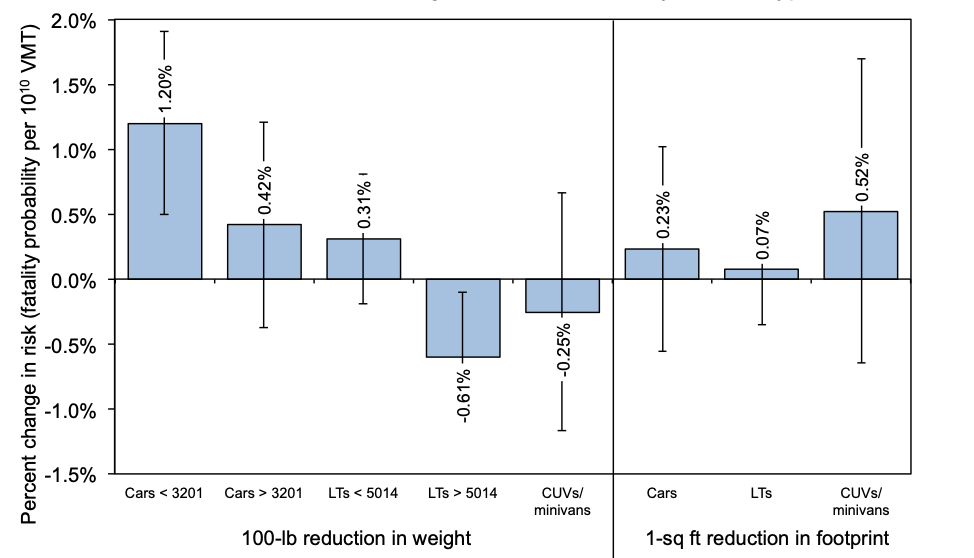 Researchers estimate the effect of a 100-lb reduction in vehicle weight on societal fatality risk; that is, the risk of any fatality in a crash, including pedestrians and cyclists, per 10 billion miles of travel. These results indicate that every 100-lb reduction in vehicle mass, holding vehicle size (i.e., footprint, or the area between the four wheels) constant, results in a 0.3% to 1.2% increase in societal fatality risk in cars and lighter-than-average light trucks, but a 0.2% to 0.6% decrease in societal fatality risk in heavier-than-average light trucks and crossover utility vehicles (CUVs) and minivans. Only the 1.2% increase in risk from making lighter cars lighter, and the 0.6% decrease in risk from making heavier trucks lighter, are statistically significant.
Researchers estimate the effect of a 100-lb reduction in vehicle weight on societal fatality risk; that is, the risk of any fatality in a crash, including pedestrians and cyclists, per 10 billion miles of travel. These results indicate that every 100-lb reduction in vehicle mass, holding vehicle size (i.e., footprint, or the area between the four wheels) constant, results in a 0.3% to 1.2% increase in societal fatality risk in cars and lighter-than-average light trucks, but a 0.2% to 0.6% decrease in societal fatality risk in heavier-than-average light trucks and crossover utility vehicles (CUVs) and minivans. Only the 1.2% increase in risk from making lighter cars lighter, and the 0.6% decrease in risk from making heavier trucks lighter, are statistically significant.
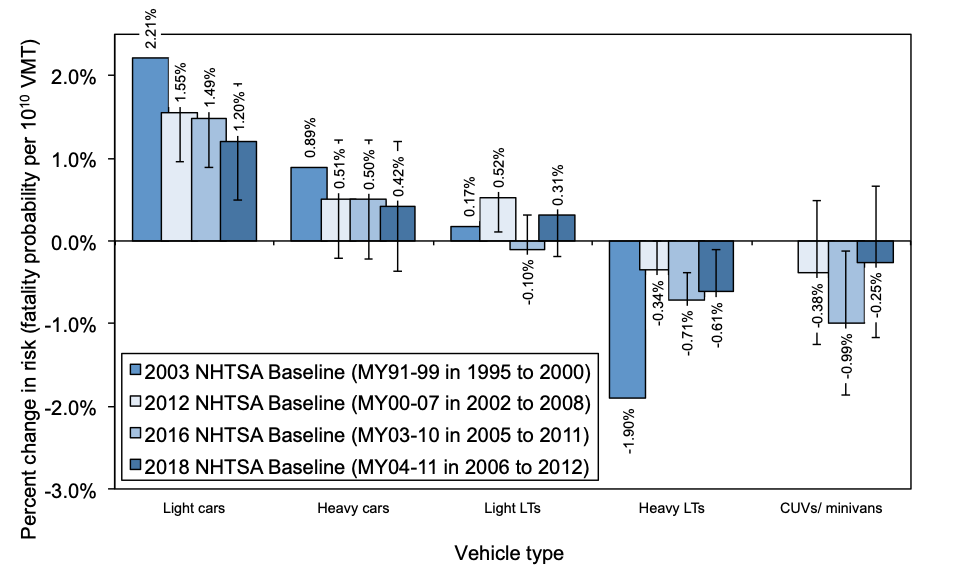
Comparison with previous statistical analyses indicates that the effect of mass reduction on both lighter- and heavier-than-average cars has consistently declined over time, as safety technologies such as airbags and electronic stability controls have mitigated any inherent disadvantage of lighter vehicles.
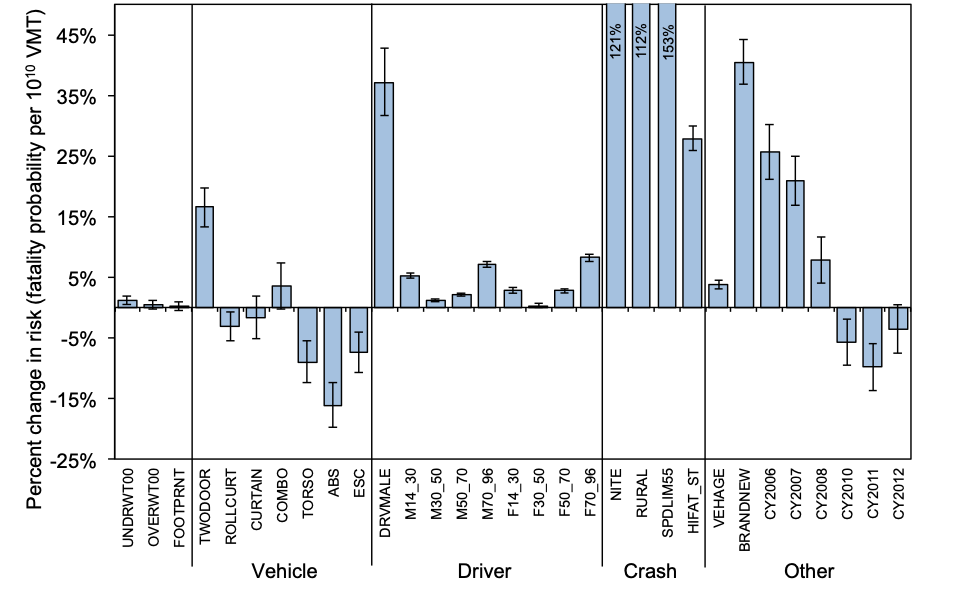
Although mass reduction in lighter-than-average cars is associated with increases in societal fatality risk, these increases are quite small compared to those associated with other vehicle attributes, driver characteristics, and crash circumstances. For instance, crashes that occur at night, in rural counties, or on high-speed (55 mph or higher speed limit) roads are associated with a societal fatality risk two orders of magnitude higher than a 100-lb increase in car mass. Similarly, crashes involving young male or elderly drivers, and occurring in two-door cars, are associated with much higher fatality risk. In contrast, vehicles with full-torso side airbags, automated braking systems, and electronic stability controls are associated with much lower fatality risks than mass reduction in cars. (Results are similar for light trucks and CUVs/minivans.)
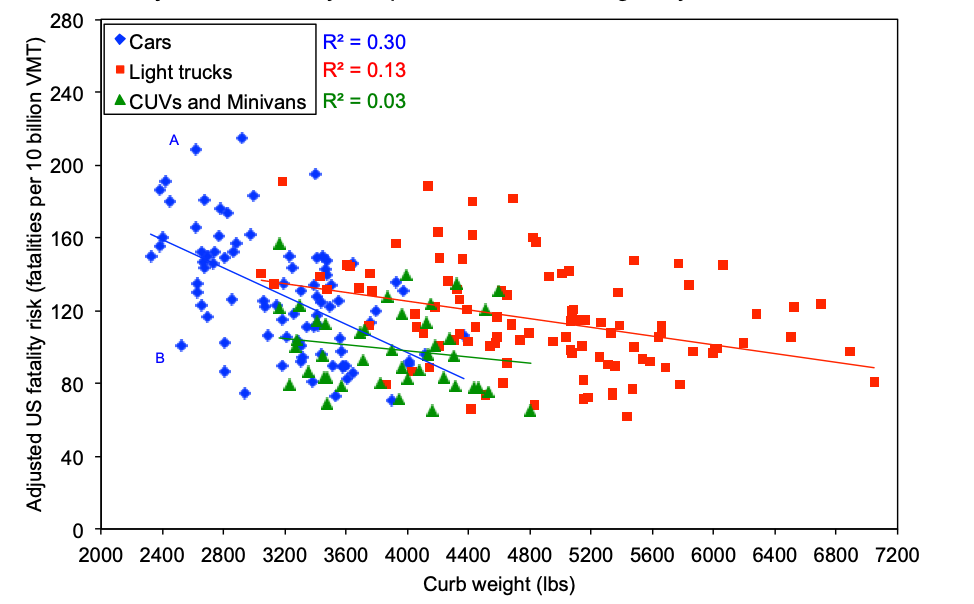 On average, societal fatality risk tends to decrease as vehicle mass increases, even after accounting for vehicle footprint and other attributes, driver characteristics, and crash circumstances. However, the correlation between adjusted fatality risk and the curb weight of cars is low, on the order of 0.30, suggesting that the design of individual car models can mitigate any safety penalty from making cars lighter. For example, the adjusted societal fatality risks of a Honda Fit, Toyota Prius, and Volkswagen Passat are half that of the Dodge Neon, Chevrolet Cobalt, and Pontiac G6, which are of comparable weight. And societal fatality risk in a Fit is comparable to that in a Lincoln Town Car or Mercury Grand Marquis, which weigh over 1500 lbs. more.
On average, societal fatality risk tends to decrease as vehicle mass increases, even after accounting for vehicle footprint and other attributes, driver characteristics, and crash circumstances. However, the correlation between adjusted fatality risk and the curb weight of cars is low, on the order of 0.30, suggesting that the design of individual car models can mitigate any safety penalty from making cars lighter. For example, the adjusted societal fatality risks of a Honda Fit, Toyota Prius, and Volkswagen Passat are half that of the Dodge Neon, Chevrolet Cobalt, and Pontiac G6, which are of comparable weight. And societal fatality risk in a Fit is comparable to that in a Lincoln Town Car or Mercury Grand Marquis, which weigh over 1500 lbs. more.
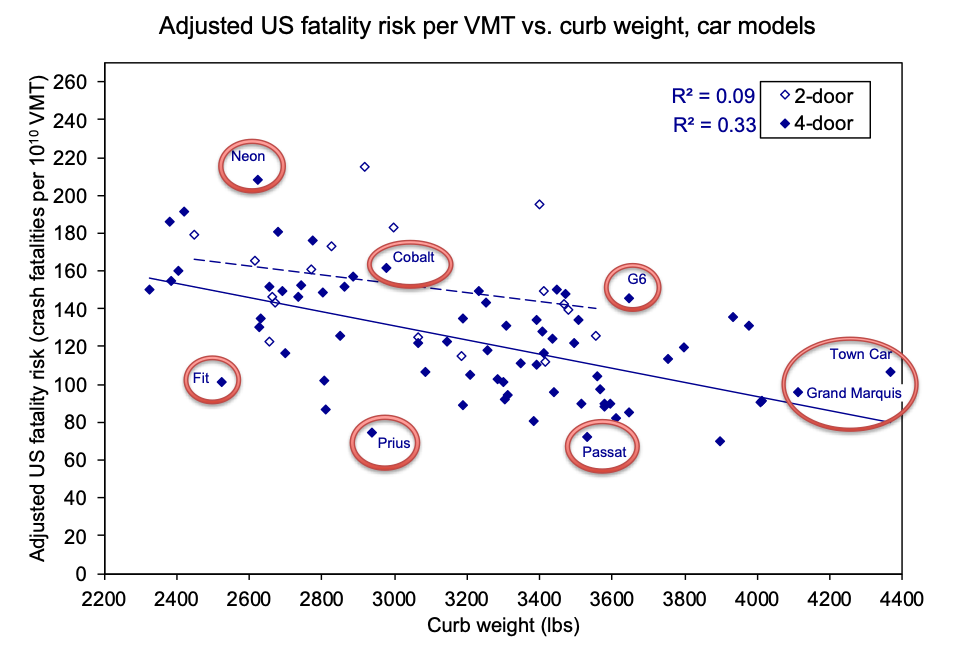
Wenzel, Thomas P. Assessment of NHTSA’s Report “Relationships Between Fatality Risk, Mass, and Footprint in Model Year 2004-2011 Passenger Cars and LTVs” (LBNL Phase 1). 2018. LBNL-2001137.
 Researchers estimate the effect of a 100-lb reduction in vehicle weight on societal fatality risk; that is, the risk of any fatality in a crash, including pedestrians and cyclists, per 10 billion miles of travel. These results indicate that every 100-lb reduction in vehicle mass, holding vehicle size (i.e., footprint, or the area between the four wheels) constant, results in a 0.3% to 1.2% increase in societal fatality risk in cars and lighter-than-average light trucks, but a 0.2% to 0.6% decrease in societal fatality risk in heavier-than-average light trucks and crossover utility vehicles (CUVs) and minivans. Only the 1.2% increase in risk from making lighter cars lighter, and the 0.6% decrease in risk from making heavier trucks lighter, are statistically significant.
Researchers estimate the effect of a 100-lb reduction in vehicle weight on societal fatality risk; that is, the risk of any fatality in a crash, including pedestrians and cyclists, per 10 billion miles of travel. These results indicate that every 100-lb reduction in vehicle mass, holding vehicle size (i.e., footprint, or the area between the four wheels) constant, results in a 0.3% to 1.2% increase in societal fatality risk in cars and lighter-than-average light trucks, but a 0.2% to 0.6% decrease in societal fatality risk in heavier-than-average light trucks and crossover utility vehicles (CUVs) and minivans. Only the 1.2% increase in risk from making lighter cars lighter, and the 0.6% decrease in risk from making heavier trucks lighter, are statistically significant.

 On average, societal fatality risk tends to decrease as vehicle mass increases, even after accounting for vehicle footprint and other attributes, driver characteristics, and crash circumstances. However, the correlation between adjusted fatality risk and the curb weight of cars is low, on the order of 0.30, suggesting that the design of individual car models can mitigate any safety penalty from making cars lighter. For example, the adjusted societal fatality risks of a Honda Fit, Toyota Prius, and Volkswagen Passat are half that of the Dodge Neon, Chevrolet Cobalt, and Pontiac G6, which are of comparable weight. And societal fatality risk in a Fit is comparable to that in a Lincoln Town Car or Mercury Grand Marquis, which weigh over 1500 lbs. more.
On average, societal fatality risk tends to decrease as vehicle mass increases, even after accounting for vehicle footprint and other attributes, driver characteristics, and crash circumstances. However, the correlation between adjusted fatality risk and the curb weight of cars is low, on the order of 0.30, suggesting that the design of individual car models can mitigate any safety penalty from making cars lighter. For example, the adjusted societal fatality risks of a Honda Fit, Toyota Prius, and Volkswagen Passat are half that of the Dodge Neon, Chevrolet Cobalt, and Pontiac G6, which are of comparable weight. And societal fatality risk in a Fit is comparable to that in a Lincoln Town Car or Mercury Grand Marquis, which weigh over 1500 lbs. more.